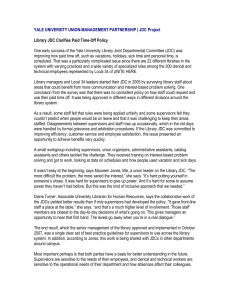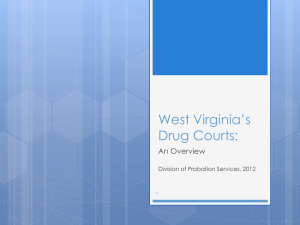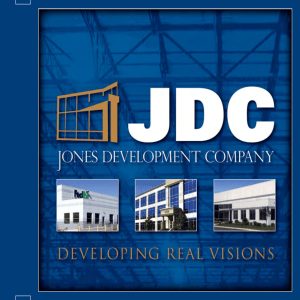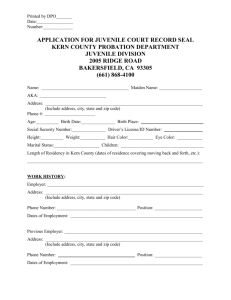School Counselor's JDC Presentation 3 26 13
advertisement
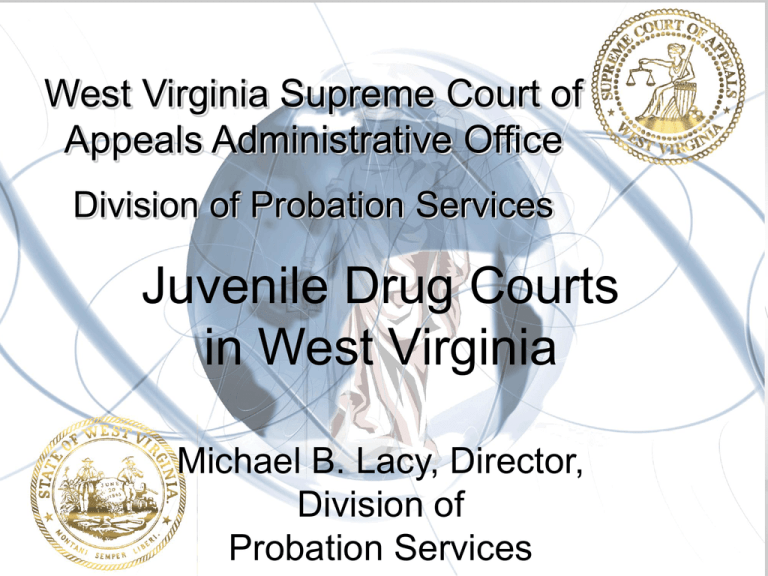
West Virginia Supreme Court of Appeals Administrative Office Division of Probation Services Juvenile Drug Courts in West Virginia Michael B. Lacy, Director, Division of Probation Services What is Juvenile Drug Court? The Juvenile Drug Court (JDC) Program is a cooperative effort of the juvenile justice, social service, law enforcement and education systems in West Virginia (WV). This program seeks to divert non-violent juvenile offenders exhibiting alcohol or substance abuse behavior from the traditional juvenile court process to an intensive, individualized treatment process which includes parental involvement and cooperation. Goal of JDC in WV The goal is to, through early/earlier intervention, prevent/reduce future Court involvement for youth involved in JDC by effectively addressing their substance abuse issues. NOTE: Early/earlier intervention could be categorized by age or by the level of substance abuse (short of addiction). The objectives of JDCs are improved individual general functioning of the participants and increased family self-sufficiency. Why Establish JDC in WV? On any given day in WV, approximately 7,000 youth are under some form of Court-ordered diversion program or supervision by a probation officer. Annual WV juvenile probation reports demonstrate that controlled substance violations are the third largest category of offenses charged. In 2007-2008, WV was one of the top 10 states for illicit drug dependence among young adults age 18-25 – National Survey on Drug Abuse and Health WV Adolescent Substance Abuse According to WV’s Adolescent Behavioral Health In Brief from SAMHSA, Sept 2009: 12,000 adolescents reported they abused or were dependent on alcohol or drugs in the past year 7,000 adolescents reported that they needed but did NOT receive treatment for drug and/or alcohol problems in the past year Note: SAMHSA defines adolescent as 12-17 years of age Development of JDC in WV Juvenile Drug Courts are designed and operated consistent with the development and rehabilitative needs of the juveniles (§49-5-2b) Supreme Court provides uniform referral, procedure and forms for the JDC (§49-5-2b) Supreme Court authorized to appoint hearing officers for juvenile drug court. Hearing officers are limited to current or senior status Circuit Court Judge or Family Court Judge (§49-5-2b) Currently, the Court has established 15 JDC programs comprising 16 courts. Existing JDC’s OPERATIONAL: Cabell County (1999, 2007-SCAWV) Wayne County (2007) Logan County (2009) Mercer County (2009) Hancock/Brooke (2010) Boone/Lincoln (2010) Monongalia County (2010) Randolph County (2010) Wood County (2010) Putnam County (2010) Kanawha (2012) Jefferson (2012) Harrison (2012) Greenbrier/Pocahontas (2012) McDowell (2012) Why is JDC Expanding in WV? Advocacy work of Director of Probation Services and Deputy Director of Drug Courts Support from all 5 WV Supreme Court Justices and the Administrative Director Support from the WV State Legislature Specifically the Education Committee which view JDC as an intervention resource for truancy and school drop out issues Viewed as a cost savings in addressing the increased need for substance abuse treatment when compared to other programs Recognition from Treatment and Criminal Justice Professionals The Division of Probation Services was asked to present on the WV JDC program OJJDP’s National Enforcing Underage Drinking Laws (EUDL) Leadership Conference in August 2011 in Orlando, FL. Requested to provide a national webinar on WV JDC’s for OJJDP’s Underage Drinking Enforcement Training Center for May 2012. WV Summit on Prescription Drug Abuse Report (2011) listed expansion of JDC’s as one of their recommendations Stemming the Tide published by the WV Center on Budget and Policy (February 2012) recommended “expanding drug courts to all counties” JDC Selection Process Juvenile drug courts must demonstrate need as well as cooperation with necessary community agencies, strong judicial leadership and agreement to follow the unified protocols. This is not a “build your own” program. It is a defined and set protocol that must be followed to allow the program as a whole to be monitored and evaluated. Is Juvenile Drug Court the same as Adult Drug Courts? No! It is basically the same concept but the eligibility criteria, practice, treatment, environment and even the case flow is different. Don’t assume JDC runs the same as an adult drug court. This would be a mistake. Philosophy of JDC is early intervention not addiction. How is JDC different than Teen Court? Teen Court is NOT a treatment court and does not involve intensive supervision, drug testing, or alcohol/substance abuse treatment services. Youth with substance abuse issues should be referred to JDC not Teen Court. Teen Court vs. Juvenile Drug Court County Teen Court Under 18 years of age Youth alleged to have committed a status offense or a misdemeanor delinquency act Alternative to filing a formal petition or proceeding to disposition. Referrals from Circuit Court Circuit Judge or member of State Bar presides. Officers of the court and the jury are teen peers. Disposition includes community service, jury service and may include educational program Probation monitors, Chief Cir. Judge oversees Juvenile Drug Court Ages 10-17 (and youth under juvenile jurisdiction until age 21) Non-violent misdemeanor or felony or drug/alcohol related status offense Referrals from judicial officials, probation, prosecutor, law enforcement, DHHR, parents Youth are the following with documented drug use: • Pre-petition Diversion • Pre-adjudicatory • Post-adjudicatory Clinical assessment of substance use/abuse Circuit Judge/Family Court Judge presides Disposition is Drug Court including: intensive supervision and substance abuse treatment for juvenile and family (family involvement required), random drug testing, community service, incentives and sanctions. JDCPO oversees Target Population Juveniles 10-17 years old Non-violent misdemeanor or felony offenders or drug/alcohol related status offenses. (Non-violent offense is defined as: an act that does not involve the use of a weapon or firearm; or an act that does not result in serious bodily injury to the victim necessitating medical treatment and may include, but is not limited to, an act of assault or battery). Youth whose psychosocial assessments demonstrate substance abuse or high risk for substance abuse/dependency. (Note: Youth assessed with an addiction may be more appropriate for in-patient treatment first followed by a possible referral to the JDC program). No previous adjudications for a sex offense How Are Youth Identified for Admission to the Program Referred By: Judicial Official Law Enforcement School Probation Officer Prosecutor DHHR Parent *A referral requires a chargeable offense. A charge does not have to be filed, but there must be an offense that would be the basis of a petition if needed. **Youth Must be Clinically Assessed Prior to Admission Entry Levels Pre-petition Diversion. JDCPO receives a referral or complaint without a juvenile petition. Participation is voluntary by the youth and parent/guardian. If the youth refuses or terminated, a petition can be initiated. Referral/complaint can be destroyed upon completion of JDC. Signed, but non-filed petition. JDCPO receives signed petition that has not been formally filed – filing held in abeyance pending the youth’s participation. Participation is voluntary by the youth and parent/guardian. Petition can be destroyed when the youth completes. If the youth refuses or terminated, the petition can be formally filed and proceed through the court system. Entry Levels Cont’d Filed petition (Pre-Adjudication) - Petition filed, but it has not proceeded through the court system or prior to adjudication the Judge refers to JDC. Adjudication is held in abeyance. Participation is voluntary by the youth and parent/guardian. At completion of JDC, the petition may be dismissed. If the youth refuses or is terminated, the youth would return to Court for adjudication. Filed petition (Post-Adjudication) Judge can make referral to JDC following adjudication, but prior to a disposition. Disposition is held in abeyance. Participation may be voluntary or non-voluntary by the youth and parent/guardian. At completion of JDC, the petition may be dismissed. If the youth refuses or is terminated, the youth would return to Court for disposition. Entry Levels Cont’d Disposition. After adjudication, the Circuit Court Judge can order the youth to participate in the JDC as a part of formal disposition (subsequent to clinical assessment), typically as a condition of probation. Participation is non-voluntary by youth and parent/guardian. When the youth completes the program, the Judge would discharge the youth from the JDC program. The Judge may or may not choose to discharge the youth from regular probation at this point. If the Judge chooses to continue regular probation, then aftercare services by the JDCPO could be ordered for a period of up to six months. If the youth fails to complete the JDC program, the youth would return to Circuit Court for modification of the earlier dispositional order. NOTE: At any level, the youth must be assessed prior to admission and the assessment must indicate substance abuse or risk for substance abuse/dependency. Who is Part of the Local JDC? One full-time probation position specifically created, funded, and dedicated to the Juvenile Drug Court. Licensed psychologist/counselor/therapist who conducts all assessments, treatment planning, treatment implementation, referral to services, and aftercare services JDC Judge (voluntary) Treatment Team (voluntary) P & E Team (voluntary) JDC Probation Officer Must meet all requirements of a probation officer Non-traditional probation work and hours Seeking experience in working with adolescents and families and with criminal justice and community partnership agencies/organizations. Knowledge of adolescent substance abuse, adolescent development, and local, statewide and national drug trends is important. JDC Treatment Provider A therapist with training in substance abuse and adolescent development Licensed or certified by their appropriate state licensing authority Must have billing capability (Medicaid and private insurance) Conducts the SASSI-A2 and CAFAS assessments (and any other appropriate screening tools used by Tx provider) Provide individual, group, and family counseling for JDC participants Actively participate on the Treatment Team and Planning and Evaluation Team JDC Treatment Team JDC Probation Officer JDC Judge Treatment Provider Prosecutor/Assistant Prosecutor Public Defender/Defense Attorney DHHR School DJS* JDC Planning and Evaluation Team Presiding Court Official JDC Probation Officer Treatment Provider Prosecutor/Assistant Prosecutor Public Defender/Defense Attorney Chief PO Law Enforcement DHHR BOE DJS (if available in area) Community Representatives *Although the Circuit Clerk is not a required member of the team, you must work with them in the planning phase to establish the official court record Intake, Assessment, Tx Each referred youth will be provided a dual assessment for program eligibility: 1) the juvenile drug court probation officer will conduct an intake with potential participants and a parent/guardian to explain the drug court program and policies and to screen for appropriateness of admission to the program; and 2) the treatment provider shall provide a complete clinical psychosocial evaluation, including administering the SASSI-A2 and CAFAS, and any other appropriate substance abuse screening for risk factors. The Treatment Team is the JDC supervising committee for admission and treatment matters for JDC participants. Decisions regarding final admission, treatment, and termination are made by consensus vote. The JDC Judge has the only authority to override a decision made by the Team. The program is structured as a fourphase program that each participant will complete. Phase I – can be completed in 4 weeks Phase II – can be completed in 6 weeks Phase III – can be completed in 12 weeks Phase IV – can be completed in 2 weeks – Graduation Average Program length is 8 months - varies according to youth’s success in each program phase. PROGRAM COMPONENTS • Random Drug Testing at Home and School Program Components Youth Meets with Drug Court Probation Officer Parents Meet with Drug Court Probation Officer Counseling Sessions for Youth and for Families (including a parent group) Court Appearances – for Both Youth and Parents/Guardians Community Service Incentives Sanctions for Non-Compliance (can be mandatory but must at least be used as a sanction). Successful Completion of Program Graduation from Program Complaint or Non-filed Petition Destroyed, Filed Petition may be Dismissed or Modified Six Months Aftercare Offered 1 Year tracking for recidivism – PO will maintain statistics in database and report to the Division of Probation Services JDC Caseload • • • • No more than 15 participants in Phase I of the program at the same time No more than 30 participants at any one time in the program (excluding aftercare youth) without special permission by the Deputy Director for Drug Courts. Referral process is on-going. A waiting list will be maintained when program is at full capacity. Aftercare planning for all participants JDC Treatment Specifics In addition to individual, group and family counseling and serving on the Treatment Team and P&E Team, the JDC Tx provider will also address co-occurring disorders such as depression and/or anger management. However, referrals for chronic mental illnesses will be made by the JDC treatment provider to the appropriate licensed mental health professionals. JDC Tx provider also must agree to bill all available sources such as Medicaid, Charity Care, other state and/or federal source, and private insurance. Emergency funds are available as a last resort from the WVSCA. NOTE: W. Va. Code §49-7-33 also allows for Judges to court order DHHR to pay for assessment and services for youth and parents. (JDC forms 118 & 119 and Probation Memo #2011-15) WVDJS has agreed to provide free services to JDC youth at local Youth Reporting Centers (if there is a YRC in a JDC county). Benefits Proposed reduction in court involvement, reduction in substance use/abuse and improved general functioning of program participants. (WV Juvenile Drug Court 2010 Evaluation Plan) Cost savings for the CJ system from reduced re-arrests, law enforcement contacts, court hearings, and use of detention centers. Other cost savings for the State include reduced out of home placements and decreased use of residential treatment centers. (Painting the Current Picture: A National Report Card on Drug Courts, May 2008) Recidivism rate for 2011 for JDC graduates – 14.4% M Cost Savings JDC community-based intensive supervision and outpatient treatment is approximately an 8 month program and costs an average of $6,403 per graduating youth Costs the Court approximately $4,225/youth for intensive supervision (average of 245 days at $17.24/day) Costs DHHR an average of $2,178/youth for out-patient clinical treatment. Approximately $8.89/day (Medicaid rate) for 245 days The alternative treatment for juveniles with substance abuse issues is a 6 month minimum in-patient treatment program which can cost between $44,100 to $99,000 per youth. Olympic Center (residential group facility in Kingwood) has a base rate of $245/day per youth (180 days X $245/day = $44,100) River Park Hospital in Huntington is $550/day per youth (180 days X $550 = $99,000) M NOTE: DJS Detention Facility is $400/day What do National Reports Say? “JDC’s have the potential to out-perform conventional juvenile probation or family court services” – Research Update on Juvenile Drug Treatment Courts, NADCP December 2010 “We know that drug courts out-perform virtually all other strategies that have been used with drug involved offenders” – Painting the Current Picture: A National Report Card on Drug Courts, NDCI - May 2008 “Lower rates of substance use and delinquency for the JDC participants as compared to the family court” and “JDC participants not only recidivated at a substantially lower rate, but they also served significantly less time in secure juvenile detention and residential facilities” Painting the Current Picture: A National Report Card on Drug Courts, M NDCI – July 2011 National Reports Continued “Significant positive outcomes have been reported for JDTCs that adhered to best practices and evidence-based practices identified from the fields of adolescent treatment and delinquency prevention. These practices include requiring parents to attend status hearings; holding status hearings in court in front of a judge; avoiding over-reliance on costly detention sanctions; reducing youths’ associations with drug-using and delinquent peers; enhancing parents’ or guardians’ supervision of their teens; and modeling consistent and effective disciplinary practices” – The Facts on Juvenile Drug Treatment Courts, NADCP – August 2010 M Evidence-based Approaches All JDCPO’s are currently trained (and continue to receive advanced training) in Motivational Interviewing (MI). All JDC Tx providers use MI and some version of Motivational Enhancement Therapy/Cognitive Behavior Therapy (MET/CBT) Multidimensional Family Therapy is also used in some JDC’s as the family counseling model. All JDC’s utilize the Creating Lasting Family Connections – Developing Positive Parental Influences AOD Parenting Module Evidence-based Assessments All JDC’s utilize the SASSI-A2 and CAFAS In addition: WVDHHR administers the Child and Adolescent Needs and Strengths (CANS) prior to referring to JDC. WVDJS Youth Reporting Centers utilize the Youth Level of Service/Case Management Instrument (YLS/CMI) when JDC youth are referred to them for services. JDC Evaluation Program Description Questionnaire Program Fidelity Checklist Juvenile Justice Database (JJDB) & Juvenile Drug Court Evaluation Database (JDCED) Youth Participant Exit Questionnaire Parent/Guardian Exit Questionnaire Parent Group Exit Questionnaire Contact Info Lora Maynard, Deputy Director for Drug Courts, Division of Probation Services, 304558-0145 or Lora.Maynard@courtswv.gov Tim Hanna, Drug Court Quality Assurance & Field Support Coordinator, Division of Probation Services, 304-558-0145, or Timothy.Hanna@courtswv.gov Robert McKinney, Counsel for Division of Probation Services, 304-558-0145 or Robert.McKinney@courtswv.gov
